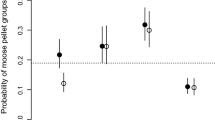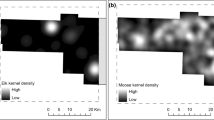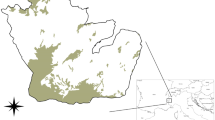Abstract
Considered as absent throughout Scandinavia for >100 years, wolves (Canis lupus) have recently naturally recolonized south-central Sweden. This recolonization has provided an opportunity to study behavioral responses of moose (Alces alces) to wolves. We used satellite telemetry locations from collared moose and wolves to determine whether moose habitat use was affected by predation risk based on wolf use distributions. Moose habitat use was influenced by reproductive status and time of day and showed a different selection pattern between winter and summer, but there was weak evidence that moose habitat use depended on predation risk. The seemingly weak response may have several underlying explanations that are not mutually exclusive from the long term absence of non-human predation pressure: intensive harvest by humans during the last century is more important than wolf predation as an influence on moose behavior; moose have not adapted to recolonizing wolves; and responses may include other behavioral adaptations or occur at finer temporal and spatial levels than investigated.



Similar content being viewed by others
References
Abramsky Z, Rosenzweig ML, Subach A (2002) The costs of apprehensive foraging. Ecology 83:1330–1340
Alexandersson H, Andersson T (1995) Nederbörd och åska [Precipitation and thunderstorms]. In: Raab B, Vedin H (eds) Klimat, sjöar och vattendrag [Climate, lakes and rivers] SNA Bokfö rlaget Bra böcker (in Swedish.), Höganäs, Sweden, pp 76–90
Arnemo JM, Kreeger TJ, Soveri T (2003) Chemical immobilization of free-ranging moose. Alces 39:243–253
Arnemo JM et al (2007) Biomedical protocols for free-ranging brown bears, gray wolves, wolverines and lynx. Norwegian School of Veterinary Science, Norway
Arnold TW (2010) Uninformative parameters and model selection using Akaike’s information criterion. J Wildl Management 74:1175–1178
Barton K (2012) MuMIn: Multi-model inference, 1.7.11 edn. R package version 1.7.11
Bates D, Maechler M, Bolker B (2012) lme4: Linear mixed-effects models using S4 classes, 0.999999-0 edn. R package version 0.999999-0
Berger J (1999) Anthropogenic extinction of top carnivores and interspecific animal behaviour: implications of the rapid decoupling of a web involving wolves, bears, moose and ravens. Proc R Soci Lond Ser B Biol Sci 266:2261–2267
Berger J, Swenson JE, Persson IL (2001) Recolonizing carnivores and naïve prey: conservation lessons from pleistocene extinctions. Science 291:1036–1039
Bjørneraas K, Van Moorter B, Rolandsen CM, Herfindal I (2010) Screening global positioning system location data for errors using animal movement characteristics. J Wildl Manage 74:1361–1366
Bjørneraas K et al (2011) Moose Alces alces habitat use at multiple temporal scales in a human-altered landscape. Wildl Biol 17:44–54
Bjørneraas K, Herfindal I, Solberg E, Sæther B-E, Moorter B, Rolandsen C (2012) Habitat quality influences population distribution, individual space use and functional responses in habitat selection by a large herbivore. Oecologia 168:231–243
Blumstein DT, Daniel JC (2005) The loss of anti-predator behaviour following isolation on islands. Proc R Soci B Biol Sci 272:1663–1668
Brown JS (1992) Patch use under predation risk: I. Models and Predictions: Annales Zoologici Fennici 29:301–309
Brown JS, Laundré JW, Gurung M (1999) The ecology of fear: optimal foraging, game theory, and trophic interactions. J Mammal 80:385–399
Burnham KP, Anderson DR (1998) Model selection and inference: a practical information-theoretic approach. Springer-Verlang, New York
Burnham KP, Anderson DR (2002) Model selection and multimodel inference: a practical information-theoretic approach, 2nd edn. Springer-Verlag, New York
Byers JA (1998) American pronghorn: social adaptations and the ghosts of predators past. University of Chicago Press, Chicago
Calenge C (2006) The package “adehabitat” for the R software: a tool for the analysis of space and habitat use by animals. Ecolo Model 197:516–519
Calenge C, Dufour A, Maillard D (2005) K-select analysis: a new method to analyse habitat selection in radio-tracking studies. Ecol Model 186:143–153
Caro T (2005) Antipredator defenses in birds and mammals. University of Chicago Press, Chicago
Cederlund GN, Okarma H (1988) Home range and habitat use of adult female moose. J Wildl Manage 52:336–343
Cederlund GN, Sand H (1991) Population dynamics and yield of a moose population without predators. Alces 27:31–40
Christianson D, Creel S (2008) Risk effects in elk: sex-specific responses in grazing and browsing due to predation risk from wolves. Behav Ecol 19:1258–1266
Ciuti S, Bongi P, Vassale S, Apollonio M (2006) Influence of fawning on the spatial behaviour and habitat selection of female fallow deer (Dama dama) during late pregnancy and early lactation. J Zool 268:97–107
Creel S, Christianson D (2008) Relationships between direct predation and risk effects. Trends Ecol Evol 23:194–201
Creel S, Winnie J, Maxwell B, Hamlin K, Creel M (2005) Elk alter habitat selection as an antipredator response to wolves. Ecology 86:3387–3397
Creel S, Winnie JA Jr, Christianson D, Liley S (2008) Time and space in general models of antipredator response: tests with wolves and elk. Anim Behav 76:1139–1146
Dussault C, Ouellet JP (2004) Behavioural responses of moose to thermal conditions in the boreal forest. Ecoscience 11:321–328
Dussault C, Ouellet JP, Courtois R, Huot J, Breton L, Jolicoeur H (2005) Linking moose habitat selection to limiting factors. Ecography 28:619–628
Edwards J (1983) Diet shifts in moose due to predator avoidance. Oecologia 60:185–189
Eriksen A et al (2011) Activity patterns of predator and prey: a simultaneous study of GPS-collared wolves and moose. Anim Behav 81:423–431
Fortin D, Beyer HL, Boyce MS, Smith DW, Duchesne T, Mao JS (2005) Wolves influence elk movements: behavior shapes a trophic cascade in Yellowstone National Park. Ecology 86:1320–1330
Frair JL, Fieberg J, Hebblewhite M, Cagnacci F, DeCesare NJ, Pedrotti L (2010) Resolving issues of imprecise and habitat-biased locations in ecological analyses using GPS telemetry data. Philosophical Transactions R Soci B Biol Sci 365:2187–2200
Frid A, Dill LM (2002) Human-caused disturbance stimuli as a form of predation risk. Conserv Ecol 6:11
Gaillard JM et al (2010) Habitat-performance relationships: finding the right metric at a given spatial scale. Philosophical Transactions R Soci B Biol Sci 365:2255–2265
Garrott RA, White PJ, Rotella JJ (2008) Chapter 23 The Madison Headwaters elk herd: transitioning from bottom–up regulation to top–down limitation. In: Robert A. Garrott PJW, Fred GRW (eds) Terrestrial ecology, vol Volume 3. Elsevier, pp 489–517
Gervasi V et al (2011) Predicting the potential demographic impact of predators on their prey: a comparative analysis of two carnivore–ungulate systems in Scandinavia. J Anim Ecol 81:443–454
Gervasi V, Sand H, Zimmerman B, Mattisson J, Wabakken P, Linnell JDC (2013) Decomposing risk: landscape structure and wolf behavior generate different predation patterns in two sympatric ungulates. Ecol Appl 23:1722–1734
Girard I, Ouellet JP, Courtois R, Dussault C, Breton L (2002) Effects of sampling effort based on GPS telemetry on home-range size estimations. J Wildl Manage 66:1290–1300
Haglund B (1968) De stora rovdjurens vintervanor II. Viltrevy 5:213–361
Hebblewhite M, Merrill E (2007) Multiscale wolf predation risk for elk: does migration reduce risk? Oecologia 152:377–387
Hebblewhite M, Pletscher DH, Paquet PC (2002) Elk population dynamics in areas with and without predation by recolonizing wolves in Banff National Park, Alberta. Can J Zool 80:789–799
Hernández L, Laundré JW (2005) Foraging in the ‘landscape of fear’ and its implications for habitat use and diet quality of elk Cervus elaphus and bison Bison bison. Wildl Biol 11:215–220
Hunter LTB, Skinner JD (1998) Vigilance behaviour in African ungulates: the role of predation pressure. Behav 135:195–211
Johnson DH (1980) The comparison of usage and availability measurements for evaluating resource preference. Ecology 61:65–71
Kauffman MJ, Brodie JF, Jules ES (2010) Are wolves saving Yellowstone’s aspen? A landscape-level test of a behaviorally mediated trophic cascade. Ecology 91:2742–2755
Kunkel KE, Pletscher DH (2000) Habitat factors affecting vulnerability of moose to predation by wolves in southeastern British Columbia. Can J Zool 78:150–157
Latombe G, Fortin D, Parrott L (2014) Spatio-temporal dynamics in the response of woodland caribou and moose to the passage of grey wolf. J Anim Ecol 83:185–198
Laundré JW, Hernández L, Altendorf KB (2001) Wolves, elk, and bison: reestablishing the “landscape of fear” in Yellowstone National Park, U.S.A. Can J Zool 79:1401–1409
Lavsund S, Nygrén T, Solberg EJ (2003) Status of moose populations and challenges to moose management in Fennoscandia. Alces 39:109–130
Liberg O, Bergström R, Kindberg J, von Essen H (2010) Ungulates and their management in Sweden. In: Apollonio M, Andersen R, Putman R (eds) European ungulates and their management in the 21st century. Cambridge University Press, UK, p 618
Liberg O et al (2011) Monitoring of wolves in Scandinavia
Lima SL (1995) Back to the basics of anti-predatory vigilance: the group-size effect. Anim Behav 49:11–20
Lima SL, Dill LM (1990) Behavioral decisions made under the risk of predation: a review and prospectus. Can J Zool 68:619–640
Lönnberg E (1934) Bidrag till vargens historia i Sverige. Kungliga Vetenskapsakademins skrifter i naturskyddsärenden 26:1–33
Lykkja ON, Solberg EJ, Herfindal I, Wright J, Rolandsen CM, Hanssen MG (2009) The effects of human activity on summer habitat use by moose. Alces 45:109–124
Månsson J (2009) Environmental variation and moose Alces alces density as determinants of spatio-temporal heterogeneity in browsing. Ecography 32:601–612
Månsson J, Andrén H, Sand H (2011) Can pellet counts be used to accurately describe winter habitat selection by moose Alces alces? Eur J Wildl Res 57:1017–1023
Mao JS et al (2005) Habitat selection by elk before and after wolf reintroduction in Yellowstone National Park. J Wildl Manag 69:1691–1707
Martin J, Basille M, Van Moorter B, Kindberg J, Allaine D, Swenson JE (2010) Coping with human disturbance: spatial and temporal tactics of the brown bear (Ursus arctos). Can J Zool 88:875–883
Mech LD, Smith DW, Murphy KM, MacNulty (2001) Winter severity and wolf predation on a formerly wolf-free elk herd. J Wildl Manag 65:998–1003
Metz MC, Smith DW, Vucetich JA, Stahler DR, Peterson RO (2012) Seasonal patterns of predation for gray wolves in the multi-prey system of Yellowstone National Park. J Anim Ecol 81:553–563
Mohr CO (1947) Table of equivalent populations of North American small mammals. Am Midl Nat 37:223–249
Neumann W, Ericsson G, Dettki H, Arnemo JM (2011) Effect of immobilizations on the activity and space use of female moose (Alces alces). Can J Zool 89:1013–1018
Olsson M, Cox J, Larkin J, Widén P, Olovsson A (2011) Space and habitat use of moose in southwestern Sweden. Eur J Wildl Res 57:241–249
Pettorelli N, Vik JO, Mysterud A, Gaillard JM, Tucker CJ, Stenseth NC (2005) Using the satellite-derived NDVI to assess ecological responses to environmental change. Trends Ecol Evol 20:503–510
Preisser EL, Bolnick DI, Benard MF (2005) Scared to death? The effects of intimidation and consumption in predator–prey interactions. Ecology 86:501–509
R Development Core Team (2010) R: A language and environment for statistical computing, R Foundation for Statistical Computing, 2.11.1 edn, Vienna, Austria
Ripple WJ, Beschta RL (2004) Wolves and the ecology of fear: can predation risk structure ecosystems? Bioscience 54:755–766
Robinson B, Hebblewhite M, Merrill E (2010) Are migrant and resident elk (Cervus elaphus) exposed to similar forage and predation risk on their sympatric winter range? Oecologia 164:265–275
Rönnegård L, Sand H, Andrén H, Månsson J, Pehrson Å (2008) Evaluation of four methods used to estimate population density of moose Alces alces. Wildl Biol 14:358–371
Sæther BE, Engen S, Lande R (1996) Density-dependence and optimal harvesting of fluctuating populations. Oikos 76:40–46
Sand H, Zimmermann B, Wabakken P, Andren H, Pedersen HC (2005) Using GPS technology and GIS cluster analyses to estimate kill rates in wolf-ungulate ecosystems. Wildl Soc Bull 33:914–925
Sand H, Wikenros C, Wabakken P, Liberg O (2006a) Cross-continental differences in patterns of predation: will naive moose in Scandinavia ever learn? Proc R Soci B Biol Sci 273:1421–1427
Sand H, Wikenros C, Wabakken P, Liberg O (2006b) Effects of hunting group size, snow depth and age on the success of wolves hunting moose. Anim Behav 72:781–789
Sand H, Wabakken P, Zimmermann B, Johansson O, Pedersen HC, Liberg O (2008) Summer kill rates and predation pattern in a wolf–moose system: can we rely on winter estimates? Oecologia 156:53–64
Sand H, Wikenros C, Ahlqvist P, Stromseth TH, Wabakken P (2012) Comparing body condition of moose (Alces alces) selected by wolves (Canis lupus) and human hunters: consequences for the extent of compensatory modality. Can J Zool 90:403–412
Sappington JM, Longshore KM, Thompson DB (2007) Quantifying landscape ruggedness for animal habitat analysis: a case study using bighorn sheep in the Mojave Desert. J Wildl Manage 71:1419–1426
Smith DW, Peterson RO, Houston DB (2003) Yellowstone after wolves. Bioscience 53:330–340
Stubsjøen T, Sæther B-E, Solberg EJ, Heim M, Rolandsen CM (2000) Moose (Alces alces) survival in three populations in northern Norway. Can J Zool 78:1822–1830
Thaker M, Vanak AT, Owen CR, Ogden MB, Niemann SM, Slotow R (2011) Minimizing predation risk in a landscape of multiple predators: effects on the spatial distribution of African ungulates. Ecology 92:398–407
Valeix M et al (2009) Behavioral adjustments of African herbivores to predation risk by lions: spatio-temporal variations influence habitat use. Ecology 90:23–30
Van Beest FM, Mysterud A, Loe LE, Milner JM (2010) Forage quantity, quality and depletion as scale-dependent mechanisms driving habitat selection of a large browsing herbivore. J Anim Ecol 79:910–922
Vedin H (1995) Lufttemperatur [Air temperature]. In: B. Raab, Vedin H (eds) Klimat, sjöar och vattendrag [Climate, lakes and rivers] SNA Bokfö rlaget Bra böcker (In Swedish.), Höganäs, Sweden, pp 91–97
Vijayan S, Morris DW, McLaren BE (2012) Prey habitat selection under shared predation: tradeoffs between risk and competition? Oikos 121:783–789
Wabakken P, Sand H, Liberg O, Bjärvall A (2001) The recovery, distribution, and population dynamics of wolves on the Scandinavian peninsula, 1978–1998. Can J Zool 79:710–725
Wabakken P et al (2011) The wolf in Scandinavia: Status report of the 2009–2010 winter (in Norwegian with English summary). In: 1:2011 On (ed) Oppdragsrapport no., vol. Oppdragsrapport no. 1:2011, Høgskolen i Hedmark
Winnie J Jr, Creel S (2007) Sex-specific behavioural responses of elk to spatial and temporal variation in the threat of wolf predation. Anim Behav 73:215–225
Wirsing AJ, Cameron KE, Heithaus MR (2010) Spatial responses to predators vary with prey escape mode. Anim Behav 79:531–537
Worton BJ (1989) Kernel methods for estimating the utilization distribution in home range studies. Ecology 70:164–168
Acknowledgments
We are indebted to J.M. Arnemo, and P. Ahlqvist, who captured and handled the wolves and to P. Grängstedt who captured the moose. We would like to thank H. Andrén, J. López-Bao, P. Krausman, and M. Kohl for their thoughtful insights, statistical interpretation and discussions about this work. Financial support was given from the Swedish Environmental Protection Agency, and two private foundations Marie-Claire Cronstedts Stiftelse and Carl Tryggers Stiftelse. The study was performed in compliance with the Swedish Committee of Animal Welfare (Permit C281/6 & C315/6).
Author information
Authors and Affiliations
Corresponding author
Additional information
Communicated by Ilpo Kojola.
Electronic supplementary material
Below is the link to the electronic supplementary material.
Rights and permissions
About this article
Cite this article
Nicholson, K.L., Milleret, C., Månsson, J. et al. Testing the risk of predation hypothesis: the influence of recolonizing wolves on habitat use by moose. Oecologia 176, 69–80 (2014). https://doi.org/10.1007/s00442-014-3004-9
Received:
Accepted:
Published:
Issue Date:
DOI: https://doi.org/10.1007/s00442-014-3004-9




